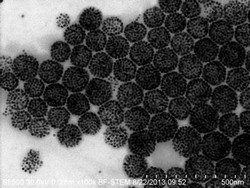Controlled assembly of nanoparticle clusters
Nanoparticles are tiny materials with at least one dimension less than 100 nm in length, 10 times smaller than the diameter of a human blood cell. The ability to fully exploit the potential of engineered nanoparticles relies on excellent knowledge of and control over their synthesis and assembly for tailor-made properties and functions. EU-funded scientists working on the project UNION (Ultra-versatile nanoparticle integration into organized nanoclusters) set out to develop the requisite technology for controlling nanoparticles. It was hoped that controlled preparation of hierarchically ordered nanoparticle clusters (NPCs) will lead to a new generation of nanotechnology products. The consortium of eight multidisciplinary research partners including four commercial companies was well-qualified to develop application-driven, scalable and cost-effective processes. Careful attention to environmental, health and safety (EHS) assessment and a roadmap for commercialisation ensured that the technologies rapidly made it to market to provide maximum benefits for EU manufacturers and the European economy. Scientists targeted three types of hierarchical materials for the different application areas. Biomedical applications exploited individual lipid-encapsulated magnetic NPCs and are expected to lead to pioneering diagnostics and drug delivery systems. Supported 2D arrays of plasmonic/fluorescent NPCs are in the pipeline for advanced high-throughput sensing and lighting applications. 3D nanocomposites for thermoelectric systems (that produce electricity from a temperature difference or vice versa) appear particularly promising with regard to electric power generation and solid-state cooling. Numerous NPCs for all applications were synthesised and characterised. Tools to support design and preparation of the hierarchical NPCs included a monitoring technique based on in situ light scattering to assess nanoparticle size in real time and validated models of the NPC assembly process. To ensure commercial potential, researchers developed protocols for assessment of the EHS and life-cycle analyses of the nanomaterials. UNION outcomes included a large library of novel nanoparticles and NPCs with interesting properties, produced at a scale using environmentally friendly processes. These processes have been shown to reduce environmental impact over their life cycle and have undergone commercial assessment. The novel assembly and monitoring techniques for production of tailor-made hierarchically ordered NPCs will enable designers and engineers to imagine and realise novel devices in many fields with significant socioeconomic impact. In addition, 26 papers have been published in leading peer-reviewed scientific journals.
Keywords
Nanoparticles, UNION, nanoclusters, environmental, health and safety, nanomaterials

